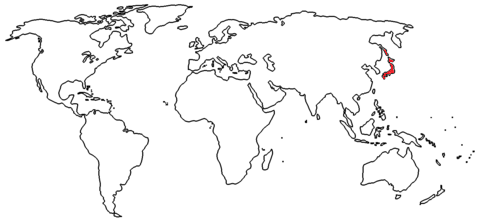
Kunashir Island Ratsnake
Elaphe climacophora
Phylum: Chordata
Class: Reptilia
Order: Squamata
Suborder: Serpentes
Family: Colubridae
Genus: Elaphe
Species: E. climacophora
Conservation Status: This species of ratsnake is widespread with healthy populations. In the city of Iwakuni a population of amelanistic animals naturally occurs, these animals receive protection as a national monument.
Natural History: Found across the island country of Japan and many of the surrounding islands, the Kunashir island ratsnake is one of Japans most widespread colubrids. Occurring in a variety of colors and hues from greens, browns, yellows and even a striking blue phase. These versatile ratsnakes inhabit almost every environment, from deciduous woodland, grassland, conifer and montane forests and even in rural or urban human developed areas. Like many species of snakes climacophora prefer to avoid confrontation and predators, during broad daylight they often seek out shelter under fallen trees, rocks, thick vegetation tangles and man made debris. They are also agile climbers and will spend a good bit of time above ground in tree branches, avoiding detection or hunting birds, eggs or small mammals. These unspecific predators feed on a variety of prey, younger animals typically hunt frogs or lizards, and increase their palate with size and age. Kunashir island rats are quite fond of bird eggs, and have a novel evolutionary adaptation that assists them in feeding on these delicacies. From the head down, the 29th through the 44th vertebrae have an extended sickle shaped structure with a small bony extension that aids in cracking the egg shell as it is swallowed.
Care in Captivity: These large colubrids are fairly easy to care for, kept in a spacious tub or enclosure they present few issues. They are very tolerant of temperature fluctuations and I provide my animals with a basking location that reaches the low 80's with a cool side in the mid 70's and a nighttime temperature drop of 3-5 degrees fahrenheit. They will periodically utilize climbing branches if the habitat permits some verticality, but a secure hide box is still necessary to provide a comfortable retreat. Juvenile specimens start readily on pinky mice and adults take frozen thawed adult mice or chicks very well. These large, up to 60" colubrids are normally shy but I have maintained specimens with strong feed responses and territorial defensive behavior while in their enclosure.
Captive Reproduction: I cycle my Kunashir island rats much as I do any species of temperate colubrid snake. In early November I fast the animals for 15-20 days to ensure all previously consumed prey are fully processed through the digestive system. While fasting the animals, at around day 10 I begin reducing the temperature on the the thermostat a few degrees a day. Once I am sure they are empty I remove them from their rack enclosures and place them in large sweater box tubs that have a deep layer of aspen shavings, a hide box and a water bowl. These tubs are then relocated to an area of my house that I allow to reach lower temperatures in the winter months. The snakes are brumated at a temperature of 45-55 degrees fahrenheit until mid February. While brumating, no food is offered and disturbances are kept to a minimum. Once weekly I clean and replace the water bowls, on warmer days the animals will emerge to drink and maintain hydration during the brumation. Mid February I remove the animals from brumation and return them to their normal housing, slowly raising the temperature daily until it returns to pre-brumation norms. I begin offering prey 7-10 days after emergence from the cold room and ensure that the females I intend to breed are offered prey every five days or so. After the female has her first post brumation shed I begin pairing the animals, every 2-3 days I'll move the male into the females enclosure until I have witnessed multiple successful locks. The male will position his body above or along side the females and begin a series of muscular 'twitches', the female may or may not respond in likewise behavior. After copulation the animals are separated and 2-3 weeks later a large laying tub is offered to the female. I use size appropriate rubbermaid tubs with entry holes cut into the lid and filled with very slightly damp sphagnum moss. The female will typically deposit a clutch of 6-10 eggs 35-50 days after initial pairings. The eggs are removed and incubated in tubs with course vermiculite and water mixed to a 1:1 ratio by weight and a small amount of very slightly damp sphagnum moss. Temperatures should be around 80-83, humidity at 80-90%. Remember, you want humidity not wetness! The first eggs will begin to pip at approximately 50-65 days, regardless of the color form of your adults all babies will be a uniform olive brown with mottled patterns.
Our Animals: We maintain a small group of climacophora, a nice green pair of adults and a very beautiful pair of blue phase animals. While color of adults can be indicative of what they will produce, it cannot be guaranteed that offspring from our blue animals will in turn mature into blue adult ratsnakes.
